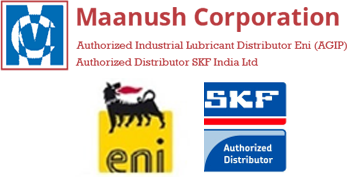Rollar Bearings

Needle roller bearings
SKF needle roller bearings are bearings with cylindrical rollers that are small in diameter relative to their length. The ends of the rollers are relieved slightly to modify the line contact between the rollers and raceways. This prevents stress peaks at the roller ends to extend bearing service life. In spite of their low cross section, needle roller bearings have a high load carrying capacity. Therefore, they are extremely suitable for bearing arrangements where radial space is limited. .
Tapered roller bearings
Tapered roller bearings have tapered inner and outer ring raceways and tapered rollers. They are designed to accommodate combined loads, i.e. simultaneously acting radial and axial loads. The projection lines of the raceways meet at a common point on the bearing axis (fig. 1) to provide true rolling and low friction. The axial load carrying capacity of tapered roller bearings increases with increasing contact angle α. The size of the angle is related to the calculation factor e (→ product tables): the larger the value of e, the larger the contact angle. A single row tapered roller bearing is typically adjusted against a second tapered roller bearing.
Spherical roller bearings
Spherical roller bearings have two rows of rollers, a common sphered outer ring raceway and two inner ring raceways inclined at an angle to the bearing axis (fig. 1.) The centre point of the sphere in the outer ring raceway is at the bearing axis. Therefore, the bearings are self-aligning (fig. 2) and insensitive to misalignment of the shaft relative to the housing, which can be caused, for example, by shaft deflection. Spherical roller bearings are designed to accommodate heavy radial loads, as well as heavy axial loads in both directions.
CARB toroidal roller bearings
CARB toroidal roller bearings (fig. 1) combine the self-aligning capability of spherical roller bearings with the axial displacement ability of cylindrical roller bearings (fig. 2). CARB bearings can also have the compact cross section and high load carrying capacity normally associated with needle roller bearings.
Cylindrical roller thrust bearings
SKF cylindrical roller thrust bearings are designed to accommodate heavy axial loads and shock loads. They must not be subjected to any radial load.
The ends of the rollers are relieved slightly to modify the line contact between the raceways and rollers. This prevents stress peaks at the roller ends to extend bearing service life..
Needle roller thrust bearings
SKF needle roller thrust bearings are fitted with a form-stable cage to reliably retain and guide a large number of needle rollers. The very small diameter deviation of the rollers within one assembly enables these bearings to accommodate heavy axial loads and shock loads. The ends of the rollers are relieved slightly to modify the line contact between the raceways and rollers. This prevents stress peaks at the roller ends to extend bearing service life.
Needle roller thrust bearings provide a high degree of stiffness within a minimum axial space. In applications where the faces of adjacent machine components can serve as raceways, needle roller thrust bearings take up no more space than a conventional thrust washer.
Tapered roller thrust bearings
Tapered roller thrust bearings enable axially very compact bearing arrangements to be produced which can carry very heavy axial loads, are insensitive to shock loads and are stiff. SKF produces single direction tapered roller thrust bearings (fig 1) and double direction tapered roller thrust bearings (fig 2). The screw-down bearings (fig 3) constitute a special design of single direction tapered roller thrust bearing and have a full complement of rollers. They are used for rolling mill screw-down arrangements.
Spherical roller thrust bearings
SKF spherical roller thrust bearings have specially designed raceways and accommodate a large number of asymmetrical rollers. The rollers have an optimum conformity with the washer raceways to optimize load distribution along the roller length. Therefore, they can accommodate relatively high speeds, heavy axial loads in one direction and heavy radial loads. The load is transmitted between the raceways at an angle to the bearing axis (fig. 1). Spherical roller thrust bearings are self-aligning and can accommodate misalignment of the shaft relative to the housing, which can be caused, for example, by shaft deflection..


